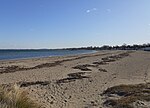Squantum

Squantum is a neighborhood of Quincy, Massachusetts, connected to the mainland by a causeway that crosses over a wetland area of the bay. Often thought of as a peninsula, Squantum proper is technically a barrier island as it is surrounded on all four sides by water and is only connected to the mainland and Moon Island via causeways. Located in the northernmost portion of the city, Squantum is bordered on the north by Dorchester Bay and Boston Harbor, on the east by Moon Island and Quincy Bay, on the south by Quincy Bay and North Quincy, and on the west by the Marina Bay development. The population of the neighborhood in 2000 according to the United States Census Bureau was 2,626. Squantum has scenic, waterfront views of Boston Harbor and the Boston skyline and has many of Quincy’s most expensive homes. Squantum residents are the wealthiest of any neighborhood in Quincy, according to the 2010 United States Census Bureau, and the home ownership rate is approximately 92%. The neighborhood is further characterized by its tree-lined streets, its "island getaway" feel, close-knit community, and its annual Squantum Fourth of July Parade. As described in a 2020 book, "One road leads in and out of a square mile of land that is a playground for children and a haven for adults." Squantum also has one of the largest Irish populations, on a per capita basis, of any neighborhood in the United StatesThe neighborhood includes two public beaches (Nickerson Beach and Orchard Beach), as well as state-owned Squantum Point Park, which has hiking trails and points for canoeing or kayaking. It is also home to Squantum Elementary School and the First Church of Squantum.
Excerpt from the Wikipedia article Squantum (License: CC BY-SA 3.0, Authors, Images).Squantum
Meadow Street, Quincy
Geographical coordinates (GPS) Address Nearby Places Show on map
Geographical coordinates (GPS)
| Latitude | Longitude |
|---|---|
| N 42.296 ° | E -71.012 ° |
Address
Meadow Street 32
02171 Quincy
Massachusetts, United States
Open on Google Maps








